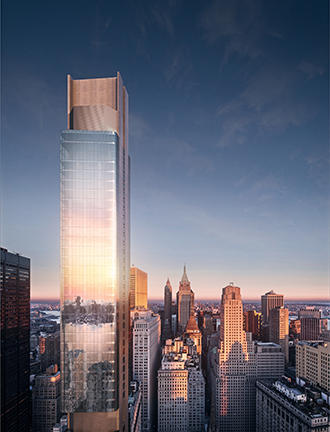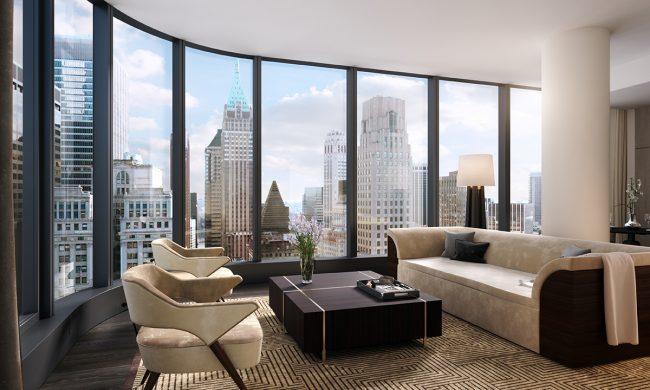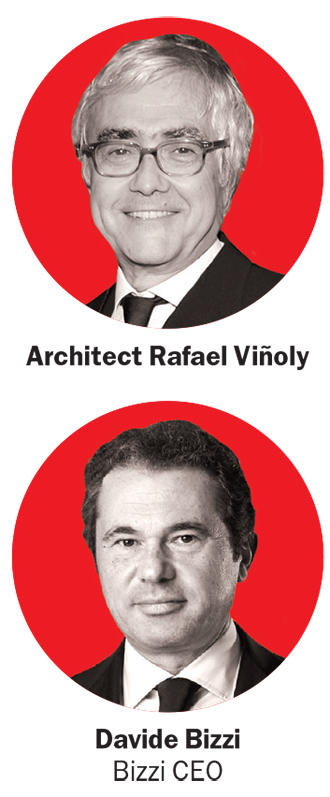Trending
Original, but not radical
Rafael Viñoly strikes again — this time at 125 Greenwich, where hard columns mixed with soft edges rule the day

Rising two blocks south of the World Trade Center site, Rafael Viñoly’s latest building, 125 Greenwich Street, was supposed to be Lower Manhattan’s answer to 432 Park Avenue.
The latter building — which stands 1,396 feet tall, and which Viñoly also designed — is visible from most anywhere in the five boroughs and is the tallest residential building in the Western Hemisphere.
But at 88 stories and 912 feet, 125 Greenwich will be a lot shorter than the 1,356 feet it was reportedly planned at back in 2014.
Although the new building’s width appears to be roughly equal to 432 Park’s, the great visual force and charm of Midtown building is its exhilarating height-to-width ratio. And that is something that 125 Greenwich, which is rising quickly after some delays, is unlikely to reproduce at its planned height.
Still, the new building will easily hold its own in the shadow of the three towers already completed at the World Trade Center site. And with no taller building to the south — at least not yet — its predominance over the southern tip of Manhattan seems assured.
While developer Michael Shvo was once the face of the project, he largely yielded to Bizzi & Partners and New Valley in the wake of his tax evasion case, which he settled in April for $3.5 million. (Last year sources told The Real Deal that Shvo retained his equity stake, which is said to be less than 10 percent.)
Either way, the tower — which will have 273 condos and launched sales this past fall —will also include a 15,000-square-foot private club known as “The 88” that will house a gym, spa, swimming pool and screening room on the top three floors.
While the original plan for the tower was 400-plus feet taller, it was actually slated to have only 77 floors and 128 units — suggesting that it was going to have larger (and pricier) units, perhaps in keeping with its Billionaires’ Row counterpart.

Interiors were designed by British firm March & White.
Instead, units at the Financial District building will range in size from 400-square-foot studios to 2,500-square-foot three-bedrooms. And prices will start at roughly $1.3 million and rise to just $6 million. The sales gallery, which is perched on the 84th floor of One World Trade, is currently showing off model units, with interiors designed by British firm March & White.
From a design stance, what works so well at 432 Park is its radical simplicity. While many observers felt — incorrectly, I believe — that the sequence of unaltered stacked modules was tedious, I found them to be brilliant.
That is less likely to be the case at 125 Greenwich, which is centered around a pair of so-called I-beams, which appear as doubled strips on two of the building’s four facades. At its summit, the pronounced flanges of the twinned I-beams poke out in a largely ornamental configuration. Both of these devices look well enough in the renderings, but we’ll have to see how they translate to reality.
Running up the entire height of the southern and northern exposures, this I-beam motif is preserved as concrete cladding at the center of the structure. But wrapped around the rest of the building are floor-to-ceiling curtain walls with softer, rounded corners, which may prove to be the most interesting and successful part of the design.
 The building is also interrupted in the center by something of a breach in the curtain wall — making the structure appear to be split into two parts. From this critic’s perspective, that feels like a gratuitous design gimmick.
The building is also interrupted in the center by something of a breach in the curtain wall — making the structure appear to be split into two parts. From this critic’s perspective, that feels like a gratuitous design gimmick.
Ultimately, Viñoly’s use of these twinned I-beams seems to engage an almost fetishistic appetite for architecture and design in contemporary culture.
In its present application, it has produced a studiously symmetrical structure that nevertheless manages to look quite original. But it is by no means radically original. While it may not look much like any specific building we’ve seen, it remains safely within the range of what progressive architects now permit themselves to do.
It is hard to see how this new project will generate the iconic, polemical interest of 432 Park. But if the truth be told, it is not incumbent on a building to be iconic or polemical in the first place.




